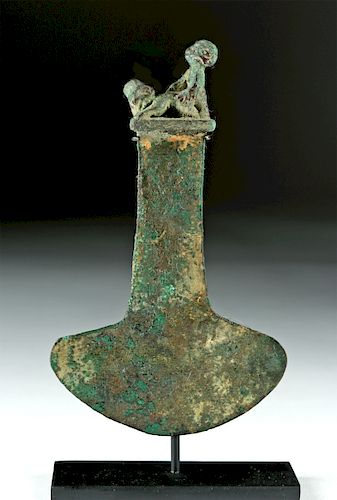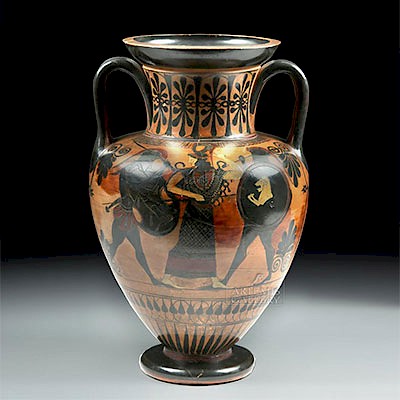Moche Copper Tumi with Amorous Figures
Lot 81b
About Seller
Artemis Fine Arts
686 S Taylor Ave, Ste 106
Louisville, CO 80027
United States
Selling antiquities, ancient and ethnographic art online since 1993, Artemis Gallery specializes in Classical Antiquities (Egyptian, Greek, Roman, Near Eastern), Asian, Pre-Columbian, African / Tribal / Oceanographic art. Our extensive inventory includes pottery, stone, metal, wood, glass and textil...Read more
Estimate:
$1,500 - $2,000
Absentee vs Live bid
Two ways to bid:
- Leave a max absentee bid and the platform will bid on your behalf up to your maximum bid during the live auction.
- Bid live during the auction and your bids will be submitted real-time to the auctioneer.
Bid Increments
| Price | Bid Increment |
|---|---|
| $0 | $25 |
| $300 | $50 |
| $1,000 | $100 |
| $2,000 | $250 |
| $5,000 | $500 |
| $10,000 | $1,000 |
| $20,000 | $2,500 |
| $50,000 | $5,000 |
| $100,000 | $10,000 |
| $200,000 | $20,000 |
About Auction
By Artemis Fine Arts
Oct 11, 2018
Set Reminder
2018-10-11 10:00:00
2018-10-11 10:00:00
America/New_York
Bidsquare
Bidsquare : Exceptional Antiquities | Ethnographic Art
https://www.bidsquare.com/auctions/artemis-gallery/exceptional-antiquities-ethnographic-art-3500
An important one-day auction featuring museum-worthy examples of classical antiquities, ancient and ethnographic art from cultures encompassing the globe. Artemis Fine Arts info@artemisgallery.com
An important one-day auction featuring museum-worthy examples of classical antiquities, ancient and ethnographic art from cultures encompassing the globe. Artemis Fine Arts info@artemisgallery.com
- Lot Description
Pre-Columbian, Peru, Moche, ca. 100 to 600 CE. A hammered copper tumi with a sculptural upper terminal depicting a couple engaged in an explicitly erotic, perhaps homoerotic, act. The blade is of a crescent-like shape - suggesting a lunar association. In addition to sexual acts, the Moche used metalworks and pottery to represent various deities, food sources, animals, cargadors, prisoners, and more. Indeed, the Moche deemed it important to record and teach about all aspects of their lives through their art. Size: 5.625" H (14.3 cm); 6.25" H (15.9 cm) on included custom stand.
Sexual acts are common imagery found in Moche ceramics as well as metalworks like this example. Scholar Paul Matheiu, in his book entitled, "Sex Pots: Eroticism in Ceramics" describes "a wide variety of sexual acts are represented: female to male fellatio is quite common; kissing and fondling; male masturbation (but never female masturbation); intercourse between heterosexual couples, in various positions; birthing scenes; also, intercourse between animals (copulating frogs, mice, dogs, llamas, monkeys, at times on corn or other food crops); and intercourse between human females and mythical animals (such as the bat and the jaguar who both had special religious connotations in Moche culture)." (Matheiu, 2003)
The Paracas people, also from the Andes, used the tumi for trepanation; although little studied, it is possible that the Moche conducted a similar practice. In modern Peru, a tumi on the wall is a symbol of good luck.
For similar examples of tumis with erotic scenes see "Cobre del Antiquo Peru - The Copper of Ancient Peru" (Paloma Carcedo Muro, 1998).
Provenance: private East Coast, USA collection
All items legal to buy/sell under U.S. Statute covering cultural patrimony Code 2600, CHAPTER 14, and are guaranteed to be as described or your money back.
A Certificate of Authenticity will accompany all winning bids.
We ship worldwide and handle all shipping in-house for your convenience.
#139383Expected surface wear commensurate with age. Wonderful blue-green patina graces the surface as well.Condition
- Shipping Info
-
All shipping is handled in-house for your convenience. Your invoice from Artemis Gallery will include shipping calculation instructions. If in doubt, please inquire BEFORE bidding for estimated shipping costs for individual items.
-
- Buyer's Premium



 EUR
EUR CAD
CAD AUD
AUD GBP
GBP MXN
MXN HKD
HKD CNY
CNY MYR
MYR SEK
SEK SGD
SGD CHF
CHF THB
THB














